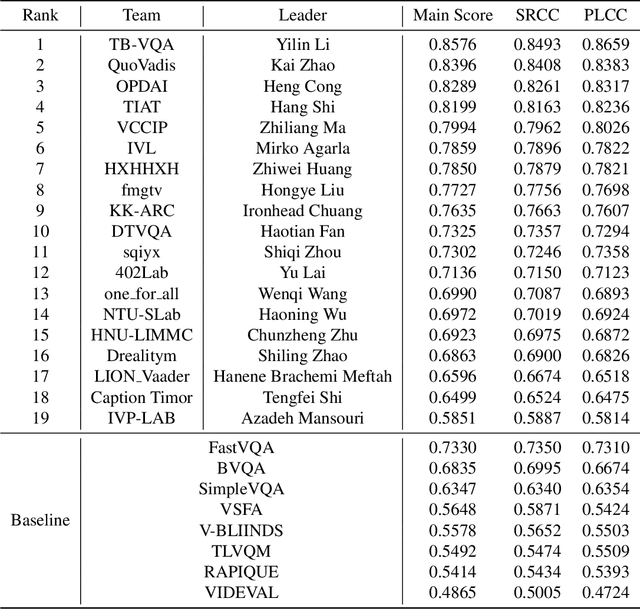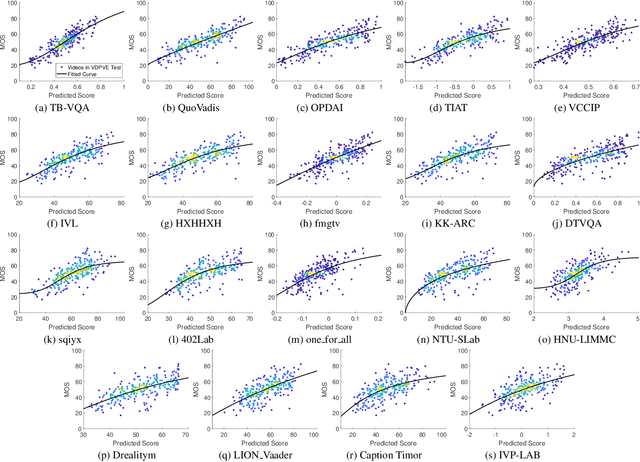Zhiliang Ma
Cross-Dataset-Robust Method for Blind Real-World Image Quality Assessment
Sep 26, 2023Abstract:Although many effective models and real-world datasets have been presented for blind image quality assessment (BIQA), recent BIQA models usually tend to fit specific training set. Hence, it is still difficult to accurately and robustly measure the visual quality of an arbitrary real-world image. In this paper, a robust BIQA method, is designed based on three aspects, i.e., robust training strategy, large-scale real-world dataset, and powerful backbone. First, many individual models based on popular and state-of-the-art (SOTA) Swin-Transformer (SwinT) are trained on different real-world BIQA datasets respectively. Then, these biased SwinT-based models are jointly used to generate pseudo-labels, which adopts the probability of relative quality of two random images instead of fixed quality score. A large-scale real-world image dataset with 1,000,000 image pairs and pseudo-labels is then proposed for training the final cross-dataset-robust model. Experimental results on cross-dataset tests show that the performance of the proposed method is even better than some SOTA methods that are directly trained on these datasets, thus verifying the robustness and generalization of our method.
A Multilayer Perceptron-based Fast Sunlight Assessment for the Conceptual Design of Residential Neighborhoods under Chinese Policy
Aug 15, 2023Abstract:In Chinese building codes, it is required that residential buildings receive a minimum number of hours of natural, direct sunlight on a specified winter day, which represents the worst sunlight condition in a year. This requirement is a prerequisite for obtaining a building permit during the conceptual design of a residential project. Thus, officially sanctioned software is usually used to assess the sunlight performance of buildings. These software programs predict sunlight hours based on repeated shading calculations, which is time-consuming. This paper proposed a multilayer perceptron-based method, a one-stage prediction approach, which outputs a shading time interval caused by the inputted cuboid-form building. The sunlight hours of a site can be obtained by calculating the union of the sunlight time intervals (complement of shading time interval) of all the buildings. Three numerical experiments, i.e., horizontal level and slope analysis, and simulation-based optimization are carried out; the results show that the method reduces the computation time to 1/84~1/50 with 96.5%~98% accuracies. A residential neighborhood layout planning plug-in for Rhino 7/Grasshopper is also developed based on the proposed model. This paper indicates that deep learning techniques can be adopted to accelerate sunlight hour simulations at the conceptual design phase.
Adaptive Control of Resource Flow to Optimize Construction Work and Cash Flow via Online Deep Reinforcement Learning
Jul 20, 2023Abstract:Due to complexity and dynamics of construction work, resource, and cash flows, poor management of them usually leads to time and cost overruns, bankruptcy, even project failure. Existing approaches in construction failed to achieve optimal control of resource flow in a dynamic environment with uncertainty. Therefore, this paper introducess a model and method to adaptive control the resource flows to optimize the work and cash flows of construction projects. First, a mathematical model based on a partially observable Markov decision process is established to formulate the complex interactions of construction work, resource, and cash flows as well as uncertainty and variability of diverse influence factors. Meanwhile, to efficiently find the optimal solutions, a deep reinforcement learning (DRL) based method is introduced to realize the continuous adaptive optimal control of labor and material flows, thereby optimizing the work and cash flows. To assist the training process of DRL, a simulator based on discrete event simulation is also developed to mimic the dynamic features and external environments of a project. Experiments in simulated scenarios illustrate that our method outperforms the vanilla empirical method and genetic algorithm, possesses remarkable capability in diverse projects and external environments, and a hybrid agent of DRL and empirical method leads to the best result. This paper contributes to adaptive control and optimization of coupled work, resource, and cash flows, and may serve as a step stone for adopting DRL technology in construction project management.
NTIRE 2023 Quality Assessment of Video Enhancement Challenge
Jul 19, 2023



Abstract:This paper reports on the NTIRE 2023 Quality Assessment of Video Enhancement Challenge, which will be held in conjunction with the New Trends in Image Restoration and Enhancement Workshop (NTIRE) at CVPR 2023. This challenge is to address a major challenge in the field of video processing, namely, video quality assessment (VQA) for enhanced videos. The challenge uses the VQA Dataset for Perceptual Video Enhancement (VDPVE), which has a total of 1211 enhanced videos, including 600 videos with color, brightness, and contrast enhancements, 310 videos with deblurring, and 301 deshaked videos. The challenge has a total of 167 registered participants. 61 participating teams submitted their prediction results during the development phase, with a total of 3168 submissions. A total of 176 submissions were submitted by 37 participating teams during the final testing phase. Finally, 19 participating teams submitted their models and fact sheets, and detailed the methods they used. Some methods have achieved better results than baseline methods, and the winning methods have demonstrated superior prediction performance.
 Add to Chrome
Add to Chrome Add to Firefox
Add to Firefox Add to Edge
Add to Edge